|
Chapter F Field Hazards 
When this ImmortalTech Keg of Maniac Beer crashes into the surface of Planet Grimdark, its automatic defense systems kick in. Two massive skeletal hands form from the volcanic strata of the planetary crust, reaching upwards through the rock only to claw back in again and tear a giant prolapsed orifice in the surface. Robotic defenders, immune (mostly) to the temptation of the Beer thanks to their mechanikal nature, spring up to man defense turrets against the sea of thirsty invaders sure to arrive. They're defended by a ring of spiked embankments, a moat of molten lava, and a great plain of unstable magma crust. Behind them, the Beer is ringed with barbed-wire fences and proximity mines. The most lethal factor, however, is the irresistible nature of the Beer itself. No matter how many invaders combine forces to breach the defenses, only one can escape with the Keg, and each attacker will stop at nothing to make sure he's that one. own photo
When offensive weaponry isn't enough to finish the job, any minifigs they missed can be slaughtered by the environment itself. Field Hazards like minefields, bear traps, electrified surfaces, razor wire, and poorly-labeled latrine pits all have the potential to ruin an intruder's day. They may be constructed by factions to support their tactical goals, or they may be natural environmental hazards, equally dangerous to all players and not belonging to any of them. Most Field Hazards don't take a lot of input or oversight from minifig controllers. Their effects are triggered when a minifig or other object wanders into the wrong area. Anti-personnel mines blow up minifigs who step on them, magma flows burn minifigs that bathe in them, and poison gas chambers poison minifigs that breathe in them after the benevolent AI has finished warming up the neurotoxin emitters. A Field Hazard is defined by two attributes: the Field, which is the Hazard's area of effect, and the Hazard, which is what happens to victims who wander into the Field. 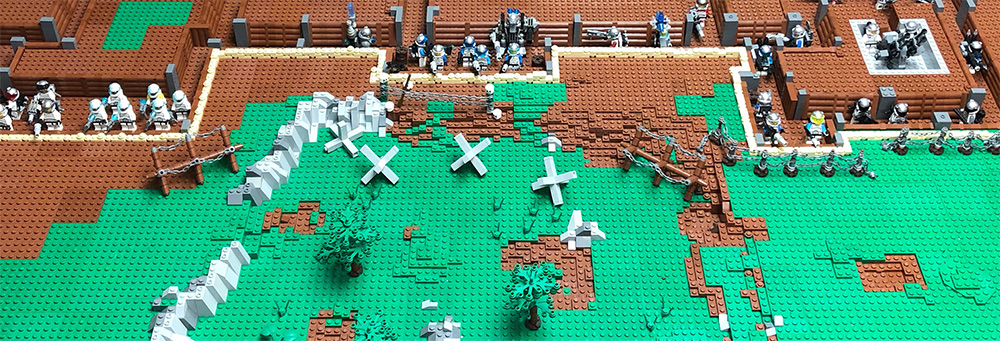
Trenches, barbed wire, and tank traps are this Skion colony's first line of defense as they work to set up artillery emplacements and fortified walls. image rights: Dienekes22, signed 7/28 Uploaded, final
The area covered by a dangerous condition is its Field. Some Fields are filled by a uniform Hazard, such as molten lava, tear gas, or boy-band music. Others are filled with hidden and unpredictably distributed Hazards, like antipersonnel mines, patches of thin ice, swampy sinkholes, or subterranean BrikThulhoid tentacles waiting to burst through the surface. Like structures and weapons, a Field is defined by its Size. Field Hazards are never secret. Every player at the table will know the boundaries of every minefield, although they may need to send some minifigs in to stomp around if they want to pinpoint the individual mines. The dangerous conditions within a Field are known as its Hazards. Hazards are consistent throughout their Fields — no matter where in a Field a minifig is standing, a Fire's flames are just as hot, a river's current is just as strong, and a minefield's mines are just as likely to be hiding under his next footstep. F.1 Hazard Dice
The effects of a Field Hazard are built up from Hazard dice that fall into a short list of basic categories.
Like the If a Field Hazard works passively as part of the landscape, there's no limit to the number of times its dice can be rolled in a turn, as one victim after another wanders into it. A river current sweeps away a dozen minifigs as easily as one, and a volcano melts a hundred ill-advised submarine tours as reliably as a scuba enthusiast diving solo. If a Field Hazard is a type that's activated and powered by a creation, then its Hazard dice can only activate once per turn, and each Hazard die uses an inch of Power when it activates. Powered Field Hazards can be designed to activate automatically on contact or manually by the creation's operator. Smoke is the simplest Hazard, with no dice of its own. It sometimes appears as a side effect of other Hazards. Smoke blocks vision completely for anyone looking into, out of, or through its Field, but has no other effect. Depending on the type of Smoke involved, a Smoke Field might barely cover the ground (e.g., dry ice fog) or it might billow up endlessly with no loss of opacity (e.g., a tire fire). By default, Smoke Fields are effective up to a height of five inches. or 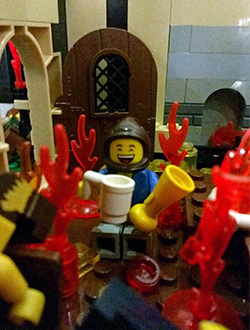 This is fine.
image rights: Sahasrahla, signed 7/29 Uploaded, final
Many Hazards damage victims through exposure alone. The Damage from environmental Hazards like acid, radiation, electrified surfaces, hailstorms, and political advertisements only increases with the victim's exposure. Whenever a unit or object encounters a Field that causes Exposure Damage, it takes the Hazard dice as direct damage. As with damage from Arc attacks, the damage total is modified by the target size modifier for whichever part of the victim is exposed to the Field (a victim large enough to have a +2 target size modifier, for example, takes +2 Damage from an Exposure Damage Field (5.1: Making Attacks)). Objects of Size zero simply take a single point of Damage per Exposure Damage die. This doesn't consume any of the Hazard's Power. Certain types of Exposure Damage work differently on different targets. A toxic gas Hazard (sometimes associated with Heroic Feats involving spicy food), for example, only affects living targets that breathe it in, leaving undead and mechanical targets unaffected. A living creature can hold its breath for one turn if it's not caught by surprise, but otherwise if its head is inside the Field then the gas affects it as if the entire body were exposed.
In addition to dealing regular damage, Exposure Damage also Overloads a target, briefly disrupting its ability to Power its own weapons and devices. Every die of Exposure Damage costs its victim one inch of Power as if it had fired an inch worth of weapons.  Lord Friedrich von Gutenberg makes a trip to the facilities on Edelheim, an M-Throne industrial planet of molten metal.
image rights: Azmi Timur, signed 7/23 Uploaded, final
 Flames shooting through cracks in the lava crust inspire BFenix's Metal Warriors to rock out for several turns in a row before remembering they're still in the middle of a battle.
own photo
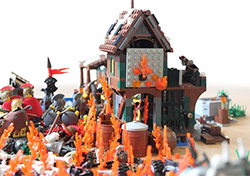 Hoping to discourage a charge from the Dragon King's cavalry, the forces of the Deposed set a ground fire. Cederic the Blacksmith's house is unintended collateral damage.
image rights: Dienekes22, signed 7/28 Uploaded, final
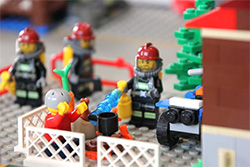 Heroic firefighters rush to suppress this civilian's backyard barbecue.
image rights: Dienekes22, signed 7/28 Uploaded, final
Fire is a special kind of Hazard. When minifigs set up a permanent fire, like a lava cauldron, nuclear reactor core, or bonfire, it functions as a normal Exposure Damage Field Hazard, and stays the same size and strength unless deliberately extinguished. Like any Fire Damage, these permanent fires can set fire to other objects, and the new non-permanent fires are much more dynamic. Burning objects make a Burning Roll each turn that lets their fire grow, spread, and change shape all by itself. Any time an object takes Fire Damage, there's a chance it will catch fire. For each individual die of Fire Damage that rolls higher than the object's Weight class, the object catches more fire. If the object wasn't on fire already, a Fire Field Hazard with one inch of Size and 1 Out of Range penalties affect a Fire Damage weapon's ability to set targets on fire, since they modify each
Units and objects that are on fire, or that are trying to use objects that are on fire, or both, take a -1 On the bright side, any target struck by a burning object or unit takes +1 Like all types of Exposure Damage, fire Overloads affected units and disrupts their ability to Power their weapons and devices for the turn. A unit on fire has its Power limit reduced by one inch for every inch of the fire's Size (for example, a four inch wooden golem burning with a three inch fire would have its Power limit reduced from eight weapon inches to five). At the beginning of its turn (or, for objects with no turns of their own, the turn of the player who set the fire), a unit or object on fire makes a Burning Roll, rolling 1 For every Fires can be extinguished with water or by rolling around on the ground. If the burning object can be submerged in water or vacuum completely, the fire is put out instantly. Otherwise, units fighting a fire can reduce its Size by by one inch per turn for every inch of firefighting apparatus they're using. (Three minifigs dumping water buckets could reduce a fire by three inches; a Size 5" fire Hose could reduce a fire's Size by five inches). Every time the fire Size changes, the player in charge of the burning object (or the player who set the fire, for unaligned objects) must adjust the physical patch of fire to match the new fire Size, adding appropriate inches of flames or yellow bricks when the fire grows, and removing inches when the fire shrinks. They can choose to adjust any side of the existing patch when adding or removing bricks, but they cannot otherwise control the fire, and the fire can't spread through physical obstacles without burning around them or destroying them first.
 With Ragnablok looming, BrikThulhu releases a control virus into every computer and robot in the BrikVerse at the same time.
image rights: Darkstorm, signed 7/24 Uploaded, final
 Not all Poison effects are wholly detrimental. Bound by their oaths to the Daemonslayer Legionidus and cast out with him from Volhalla to the shores of hell, these slain Vol warriors grow in power by drinking the blood of the Daemons they defeat. The increasing Daemonic taint in their souls is a small price to pay for unholy strength in battle and the chance to one day return to Volhalla.
image rights not secured
Fire is also used as the basis for other types of corrosive damage that have a lasting Burning effect from turn to turn.
Alternate Fire-like effects can lead to alternate final stages besides death and destruction. Infectious bites, daemonic possession, mutagenetik accidents, and religious evangelism can all turn victims into unrecognizable monsters (10.4: Monsters). Creatures and objects suffering from one of these alternate forms of Burning still feel the usual effects of being on Fire - the penalties to Armor, Action, and Power, the Burning Roll, and the ability to make whatever alternate version of a Fire attack makes sense for their condition. 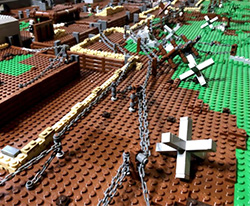 The Skion colony continues to develop its defenses. These lines of barbed wire and military-grade obstacles encourage invaders to slow down and appreciate the scenery in the locations most convenient for nearby Skion artillery pieces.
image rights: Dienekes22, signed 7/28 Uploaded, final

Riding the fastest Horse in the Rayho cavalry, a Rayho Gryphon Rider gets it stuck in the tentacle trees surrounding the VladTron fortress. Thinking quickly, he spikes his lance and pole-vaults over the top of them - but not high enough! The tentacle trees snatch him out of the air. From "Rainbow War II: Jellybean Apocalypse: Grail War" Elements shown: LEGO own photo
The purpose of Difficult Terrain is to hamper or disrupt unit movement. Difficult Terrain can slow units down or move them in directions they don't want to go. It can also let them go whichever direction they want, but decrease their ability to slow down or change course.
or  This hallway looks totally safe.
photo rights: Silent-Sigfig
signed 3/25/21 Concealed Hazards add the element of surprise to Hazardous terrain. Units are never quite sure whether their next step will crack through thin ice, drop them into quicksand, or set off a landmine. Concealed Hazard dice cost half as much as the equivalent Exposure Damage or Difficult Terrain Dice. When using Concealed Hazards, it's important to bring bricks or other markers to show spots where the Hazards have already been set off. Units may cross over the same patch of land a hundred times before the bear trap goes off on trip one hundred and one, but once triggered, hidden pits don't re-hide themselves, mine craters don't grow new mines, and falling block traps don't lift their fallen blocks back up into the ceiling to reset themselves.
A unit traveling into or through a Concealed Hazard must declare its path through the Field Hazard and then roll its Action Die to see how many inches it's able to safely travel. (This is a passive check that doesn't spend an Action.) If the distance rolled equals or exceeds the number of inches the unit is traveling through the Field, then nothing happens - the unit travels safely and continues as normal. Otherwise, the number rolled is the number of inches it traveled through the Field before setting off the Concealed Hazard. On a Critical Failure, the Concealed Hazard is triggered immediately, before the unit travels any distance at all. The larger an object is, the higher its chance of setting off a Concealed Hazard. A unit making an Action Roll to travel through a Concealed Hazard takes the reverse of its usual target size modifier. (For example, an unusually large Size 8" Cow with a +4 target size bonus to hit would take a -4 penalty to its Action Roll for traveling through a Concealed Hazard.) Size 0" objects are too small to set off Concealed Hazards at all. Objects that leap, fall, or are thrown into a Concealed Hazard roll against the number of inches traveled while airborne. On any failed roll, the consequences occur at the point of impact. Objects without an Action Die of their own roll an Incompetent If an object is being carefully set on the Concealed Hazard (for instance, by minifigs attempting to build a safe platform over unstable ground), the unit setting the object in place makes an Action Roll. Even though the object isn't traveling any distance, it can still set off the Hazard on a Critical Failure. While not Hazardous in the usual sense, Energy Shield dice are subject to the same Field Size limits as other Hazard dice. Energy Shields are not especially cost-effective as a replacement for standard Armor or Heavy Armor, but they do open up extra protection options for a creation that has already reached its maximum Weight class. An Energy Shield Die grants one level of Deflection against an incoming damage die of the proper type. Damage based on a minifig's Action Die, like Melee Weapon damage, is blocked by an Energy Shield
Energy Shields must be created by Shield Projectors somewhere on the surface of the creation they protect. Each Energy Shield Die can be spent once per turn, and costs one inch of a creation's Power for the turn when used. F.2 Traps Not all battlefield hazards are based on environmental conditions. Every once in a while, minifigs have the time and attention span to assemble something more deliberate and specific. Defense turrets, slamming blast doors, rolling boulders, strategically positioned sleeping tigers, auto-flushing toilets - if a creation, weapon, Field Hazard, or other device can be activated, then it can be engineered into a custom Trap. Trap mechanisms are not capable of initiative or independent thought, so players have to be specific about the exact conditions that activate a Trap, and what it does once activated. Traps are activated by specific triggers. Any object physically represented on the battlefield can be designated as a trigger for one or more Traps. Minifigs may be required to interact with the object in a certain way (typing the proper code into a keypad, turning the arming keys before pulling the self-destruct lever, or playing a particular tune on a skeletal pipe organ), or the trigger may be set off by any interaction at all (a loose doorknob wired with a mercury switch). Some triggers are obvious (the comedically oversized power switch, the giant red "DO NOT PUSH" button), but many are not (the disguised torch lever that opens the secret door, the throw rug over the spiked wood chipper pit). In theory, opposing minifigs won't know the location of these secret triggers, but in most cases all the players will, unless the game has an impartial moderator or host to adjudicate secrets. Often the easiest workaround for secret triggers (as well as other types of hidden objects) is to build a large number of potential triggers and roll dice whenever one is tried to see if it's the real one. Triggers are sometimes built into Concealed Hazard Fields - hidden pressure plates, motion detectors, tripwires, or some equivalent are scattered throughout the area, and tripping one of them will set off the device. (Concealed weapon traps are automatically pointed at the spot where the Hazard is activated. Even if the players can't know in advance exactly where the tripwires will be, the minifigs who built the trap presumably did.) Weapon Traps are often single-use (until reset by a minifig technician - those hidden crossbows don't re-arm themselves), and they make their attacks with an inanimate object's default Action F.3 The Scout 
Scout: own illustration Uploaded
Replace stat card design? make new Scout illustration holding Optics tool? 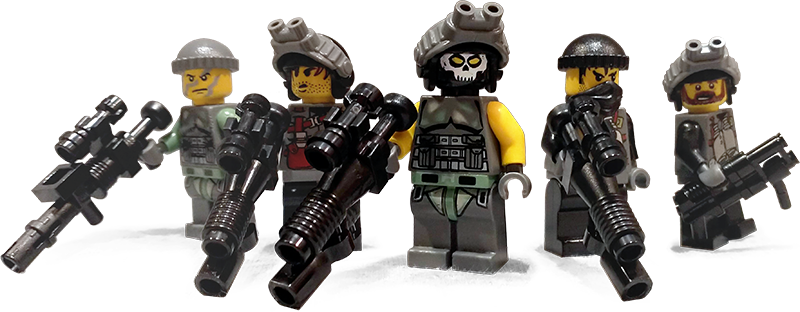
The United Systems Alliance Ranger Sergeant keeps his eyes peeled as his rangers blaze a trail headfirst into hell.
photo rights: Silent-Sigfig signed 3/25/21 When dealing with Traps and Field Hazards, most units are limited to two options: avoid them completely, or shrug and hope they survive the damage. For a faction that makes sure to always be prepared, there's a third option. With a specially-trained Scout leading the way, many Hazards can be safely bypassed or neutralized. A Scout must carry and use binoculars, a telescope, or some other optical Tool in order to take advantage of his Specialty abilities.
Pathfinding Specialty:
stops safely before setting off Concealed Hazards
A Scout has the Pathfinding Specialty, giving him the ability to recognize hidden dangers and safely navigate dangerous terrain. A Scout rolls his Specialty When traveling through Concealed Hazards, a Scout rolls his Specialty
Tracking Specialty:
automatically detects invisible units and objects;
allows Marking of targets for +1 Action Bonus for Ranged attackers
The Scout's keenly-refined paranoia and sixth sense for danger also makes him a master of detection. All units, objects, Traps, and devices within a Scout's field of view are automatically revealed to him and his allies, even if they're hidden or invisible, and their advantages from stealth or camouflage are negated. A Scout is able to instantly communicate detected enemy positions to all of his allies, which is useful for firing artillery shells or archery volleys over the tops of obstacles at enemies hiding behind them. Any target visible to a Scout is visible to all of his allies. The Scout can spend an Action to take this ability one step further, pinpointing a single target he can see within 8" and Marking it for attack. Until the beginning of the Scout's next turn, the Marked target is considered visible to all allies, and all allies making Ranged attacks on a Marked target do so with a +1 Action Bonus. Marks are not cumulative. Even with multiple Marks, the Action Bonus is still +1.
| ||||||||||||||||||||||||||||||||||||||||||||||||||||||||||||||||||||